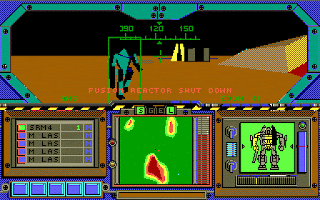Splatterhouse is an early side-scrolling horror game made by Namco. In this game, two “parapsychology” students, Rick and Jennifer, take shelter from a storm in a mansion colloquially referred to as the “Splatter House” do to the local belief that it was once the home to grizzly human experiments. You play as Rick. As you enter the mansion, Jennifer screams, and suddenly you are waking up somewhere else. You are deep inside the dungeon under the mansion. You’ve been attacked by monsters, but something called the “Terror Mask”, a sacrificial Mayan artifact. You discover that the artifact is in fact sentient and has fused itself to you, turning you into a monster with superhuman strength. The mask encourages you to go find your girlfriend, and fuelled by fear and anger (and super strength), you go on a murderous rampage through the mansion. It’s inspired by horror movies like “Friday the 13th” and “Evil Dead”, but thankfully isn’t based directly on any movie, unlike some of the much worse horror games of the era.
The game plays like a classic beat-em-up, you can jump, punch, and kick, both high and low attacks, on a side-scrolling 2D screen, giving you a lot of attack options and combinations. Like a proper beat-em-up game, you can perform a combo that will make you do a drop kick that ends with you sliding along the ground and damaging any enemies you hit. Although you are always side-scrolling left or right (with some auto-scrolling sections), there are often ways to drop down through the floor to take an alternative route through a level, if you can find them. There are many weapons you can find along the way, and at the end of each level, there’s a boss fight. One thing this game does that is pretty interesting (for the time at least) is that boss fights, although always in a usual boss room, have varying objectives and ways to succeed, it isn’t just punch the boss ‘till he’s dead. The boss isn’t always a single character, either. For example, in the first level, the boss is a room with strange growths all over it that shoots out larvae-like monsters at you rapidly.
The arcade version actually uses a checkpoint system, just sending you back a little, when you die, instead of paying more coins to continue, to avoid people spamming coins to overcome the game’s challenges (and subsequently robbing themselves, Namco, of a lot of their potential money). If you lose a life, you go back a little, and if you lose all your lives, you go back a considerable amount, but not to the beginning of the game.
Sources:
Splatterhouse Arcade Game Review
http://www.solvalou.com/subpage/arcade_reviews/240/325/splatterhouse_review.html
Splatterhouse Review - IGN
http://ca.ign.com/articles/2007/03/21/splatterhouse-review-3
Hardcore Gaming 101: Splatterhouse
http://www.hardcoregaming101.net/splatterhouse/splatterhouse.htm


















